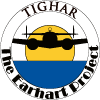 |
|
|
|
|
|
|
|
|
|
|
|
||
|
|
|
||
March 31, 1996
| Project Report: Part #40552 |
 |
An irregularly shaped piece of transparent plastic, cataloged as TIGHAR Artifact 2-3-V-2, is the first object found on Nikumaroro to which a standard Lockheed Model 10 part number can be assigned. Here’s a review of the investigative process by which that determination was made.
On the afternoon of the fourth day of the NIKU III Preliminary Expedition, team member Veryl Fenlason (#0053CE) noticed an object lying on the jungle floor in the “old village” and thought it might be a piece of Plexiglas.
Veryl brought the artifact to the attention of the expedition leader and other team members in the area and it was discussed as a candidate for collection. It was clear that this was part of a larger object made of fairly sophisticated 20th century material from which pieces had been crudely cut and broken. Its surface exhibited a slight but uniform curvature. No source of such material had been encountered elswhere in the village and the location was too far inland for it to have washed in from the sea. Other debris in the same location exhibited similar evidence of having been cut apart, suggesting that whoever lived here was something of a craftsman or tinkerer. A further search of the spot turned up another smaller shard of the same material which fit a break in the first piece. Because known aircraft parts had been found in the vicinity it seemed reasonable to speculate that this might indeed be plexiglas and to have come from an aircraft. The expedition leader made the decision to collect the two pieces for testing and cleared their recovery with the Kiribati government representative as Artifact 2-3-V-2.
Upon our return to the United States the first step was to conclusively identify the material. This was accomplished by contracting with a reputable conservation laboratory for a compositional analysis. A series of tests confirmed that the material is polymethyl methacrylate (PMMA), also known by the trade name Plexiglas. So far so good, but that didn’t make it an airplane component, much less part of the Electra. We next contacted Rohm & Haas, the company which first produced Plexiglas in the U.S., and got some history on the product. Polymethyl methacrylate was first produced in Germany by the Rohm company in 1927. In 1936, Rohm & Haas began producing it in the U.S. under the trade name “Plexiglas.” DuPont also made PMMA and called it “Lucite,” while in Britain, ICI Ltd offered the same product under the name “Perspex.” The new material was far superior to earlier cellulose-based products (Pyralin and Plasticele) used in airplanes where a curved transparent surface was needed, and by 1937 aviation maintenance manuals included instruction on how to work with plexiglas. Because it was relatively expensive, pre-war use of PMMA was limited to aviation applications and the manufacture of jukeboxes. During and immediately after the war it was almost exclusively an aviation product and didn’t come into common civilian use until the early ’50s. Because the ”old village” on Nikumaroro was abandoned in 1949 and (as far as we know) had no jukebox, we concluded that the artifact had probably come from an airplane. But what airplane?
All of the airplane parts found on Nikumaroro so far seem to fall into two categories, B-24 and Lockheed Electra. Since both aircraft could have had Plexiglas windows the next step was to look at the artifact’s curvature and thickness. Plexiglas, to be formed, must be heated to at least 90íC-a far higher temperature than could be reached just lying on the ground (even on Nikumaroro), so the curvature of the artifact is almost certainly original. To see if it is the same curvature as a Lockheed Electra cabin window we asked our friends at the New England Air Museum in Windsor Locks, Connecticut to send us one from their under-restoration Electra c/n 1052 (Earhart’s was c/n 1055). The exterior surface curve of the artifact and the window appeared to be identical. The glass from 1052, however, was tinted and twice as thick as the artifact (1/4 inch versus 1/8 inch). Early photos of 1052 show that it was not delivered with tinted windows so this must be a later replacement. The real question, of course, was how thick were the windows in Earhart’s airplane?
A search of microfilmed engineering drawings for the Lockheed Model 10 at the National Air & Space Museum’s Garber Facility in Suitland, Maryland, proved revealing. The drawing for “Part Number 40552 – Window Glass, Fuselage, Cabin” shows that a number of changes were made to the material and thickness specifications over the production life of the design (1934 to 1941). Of particular interest is a change specified for January 15, 1937 at which time the window thickness was reduced from 5/32 to 1/8 inch. The date is significant because it was just at that time that the cabin windows in Earhart’s airplane were replaced and additional special windows were installed as part of her world flight preparations. The curvature and thickness of the Plexiglas found on Nikumaroro exactly matches Lockheed’s specifications for Electra cabin windows at exactly the time Earhart’s new windows were installed.
But what about the B-24? A search of engineering drawings for the Consolidated Model 32 show that the fuselage windows of the Liberator (Part No. 32B1198) were 1/10 inch thick and had no curvature at all. The Plexiglas used in the nose and turrets was, of course, much thicker.
Our conclusion is that Artifact 2-3-V-2 is consistent in all known respects to Lockheed Part Number 40552 and is not consistent with the only other known source of airplane parts found on Nikumaroro, the Consolidated B-24.
